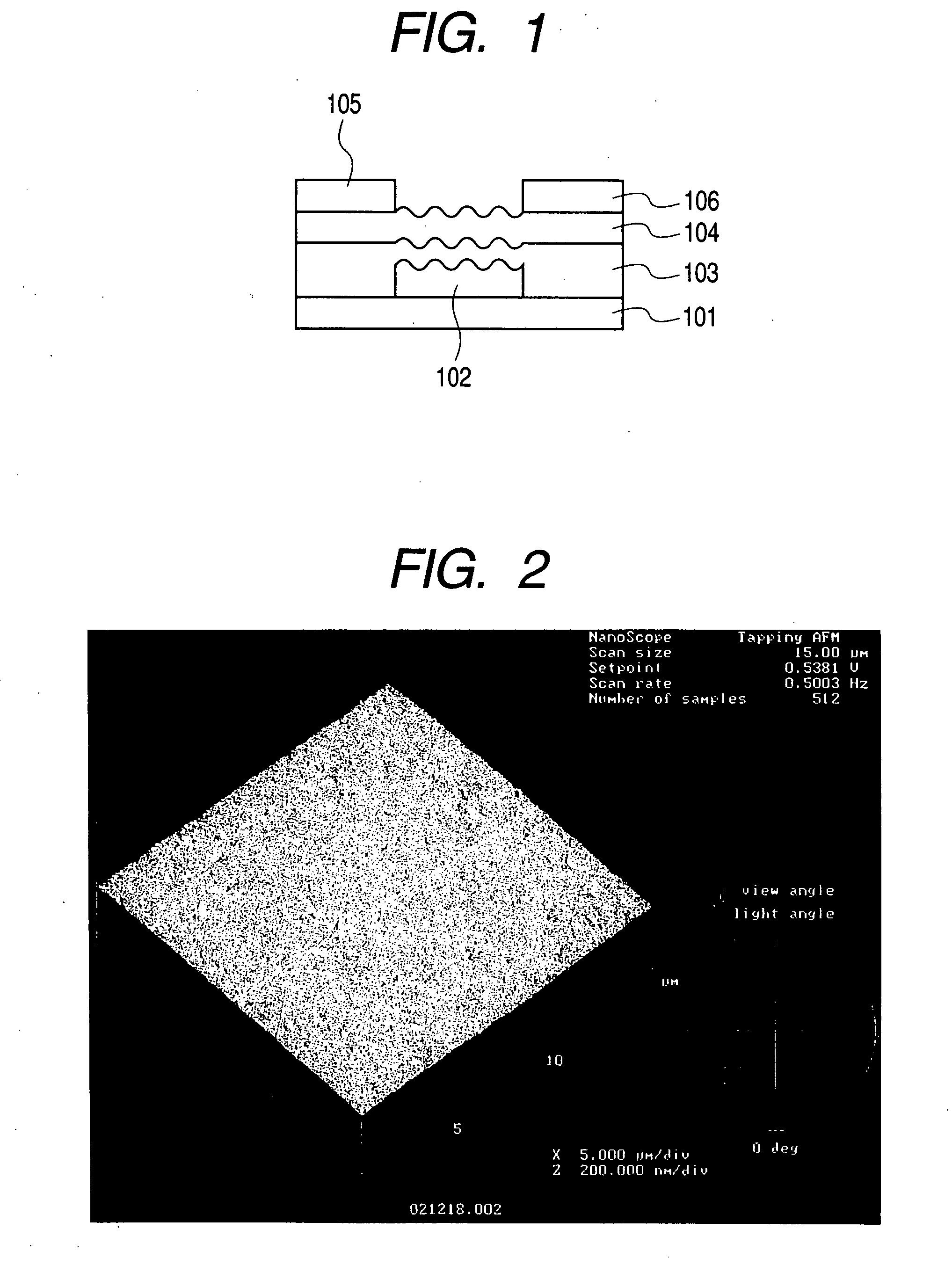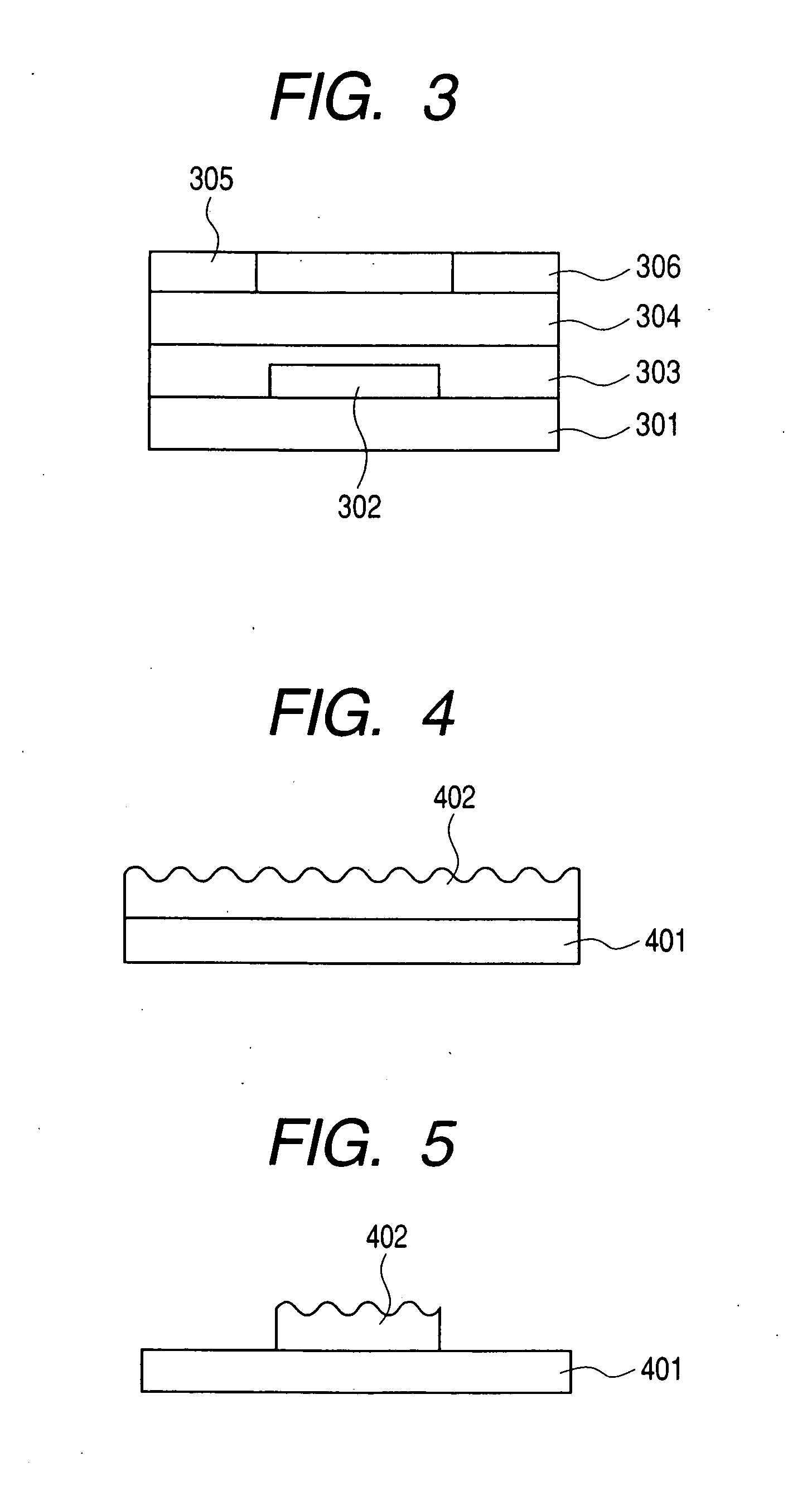Organic thin film transistor and manufacturing method thereof
a thin film transistor and organic technology, applied in the direction of thermoelectric device junction materials, semiconductor devices, electrical apparatus, etc., can solve the problems of poor coverage of the gate insulating film formed on the gate electrode, increase the leakage of the gate electrode, and achieve the effect of stable operation characteristics and low cos
- Summary
- Abstract
- Description
- Claims
- Application Information
AI Technical Summary
Benefits of technology
Problems solved by technology
Method used
Image
Examples
example 1
[0058] FIGS. 4 to 8 are schematic views showing a method of producing the organic thin film transistor according to the present invention. In FIG. 4, reference numeral 401 denotes a substrate and 402 denotes a conductor film. With respect to the substrate 401 and the conductor film 402, for example, a glass epoxy resin substrate which is integrally formed with a copper foil is commercially available as a printed circuit board. In this example, a substrate having a thickness of 0.2 mm in which a film thickness of the copper foil serving as the conductor film was 35 μm was used (produced by Hitachi Chemical Co., Ltd.; type: FR-4). A large number of substrates, each of which had a structure in which the conductor film was provided on both surfaces of the substrate. However, the conductor film provided on one surface is unnecessary on the description of the present invention and thus omitted here. The same reference numerals in FIGS. 4 to 8 indicate the same members.
[0059] Next, the co...
example 2
[0069] An organic thin film transistor was produced as in Example 1 except that polyethylene terephthalate (PET) was used for the substrate and gold was used for the gate electrode. With respect to the organic thin film transistor, a correlation between the average surface roughness Ra on the surface of the gate electrode and the incidence of defective products was examined.
[0070] The used PET was an OHP film whose thickness was 0.1 mm and size was A4. This was cut to a card side (86 mm×54 mm) as in Example 1.
[0071] A gold thin film which was to become the gate electrode was formed using a mask by resistance heating of tungsten boat in a vacuum evaporation system. In order to improve the contact of the gold thin film to the substrate, a thin chromium film was formed as a base layer. A thickness of the gold thin film was 0.5 μm and a thickness of the chromium film was 0.1 μm.
[0072] Next, a laminate of the chromium film and the gold thin film which was to become the gate electrode ...
example 3
[0074] A polyimide substrate having a thickness of 25 μm was used as the organic substrate. A copper foil having a thickness of 25 μm was grown on the substrate by plating. Four substrates each having the grown copper foil were prepared.
[0075] The four substrates were subjected to four types of surface processings, which were no polishing, soft etching processing, polishing tape processing, and CMP processing.
[0076] The conditions of the respective surface processing were as follows.
(Processing Conditions)
[0077] Soft etching processing: the substrate was immersed in 5% sulfuric acid for 30 seconds and then washed using flowing deionized water for 2 minutes. Tape processing: polishing tape (type: K8000); 60 second in polishing time; 1 m / 30 seconds in tape feed speed; and 2 kgf / cm2 in roll pressure. CMP processing: Shibaura slurry CHS-3000EM; 5 kg in cylinder pressure; 80 rpm in the number of revolutions of retainer and platen; and 25 minutes in polishing time.
[0078] The respect...
PUM
 Login to View More
Login to View More Abstract
Description
Claims
Application Information
 Login to View More
Login to View More - R&D
- Intellectual Property
- Life Sciences
- Materials
- Tech Scout
- Unparalleled Data Quality
- Higher Quality Content
- 60% Fewer Hallucinations
Browse by: Latest US Patents, China's latest patents, Technical Efficacy Thesaurus, Application Domain, Technology Topic, Popular Technical Reports.
© 2025 PatSnap. All rights reserved.Legal|Privacy policy|Modern Slavery Act Transparency Statement|Sitemap|About US| Contact US: help@patsnap.com



